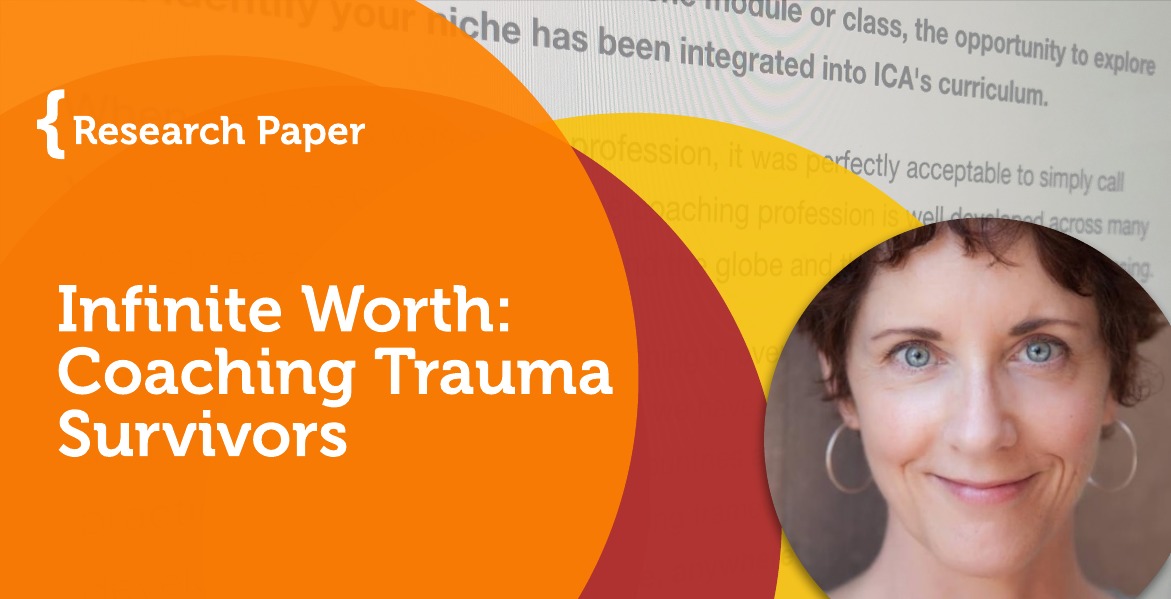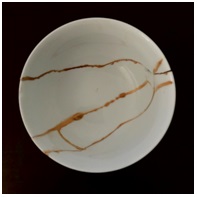 Research Paper By Mimm Patterson
Research Paper By Mimm Patterson
(Life Coach, UNITED STATES)
Introduction
 Kintsugi is the Japanese art of repairing shattered pottery with lacquer dusted or mixed with powdered gold, silver, or platinum. The broken vessel is re-formed and made more beautiful.
Kintsugi is the Japanese art of repairing shattered pottery with lacquer dusted or mixed with powdered gold, silver, or platinum. The broken vessel is re-formed and made more beautiful.
Trauma survivors are not broken.
To the individual who has experienced trauma, however, it can feel that way. Trauma fuels a sense of powerlessness in the individual. Knowing that we have the ability to choose our own path and to make our own decisions means little to the trauma survivor.
The coaching experience diffuses powerlessness like the sun burns away fog. Coaching empowers the trauma survivor and creates an environment that offers space for choice making. Choice builds strength and resilience and begins the journey toward an authentic self.
Kintsugi takes something that has been shattered and, with mindful focus and intention, makes it whole. In the process, rather than making sharp edges disappear, the art of kintsugi highlights their beauty. The sharp edges of trauma are not beautiful but, like kintsugi, coaching does not attempt to make them disappear. Instead, through attentive questioning, non-coercion and the coach’s ability to trust her instincts, the trauma survivor has a present-moment experience that informs how they show up in the world.
This paper will discuss the necessity for the coach to have an understanding of the cumulative effects of complex trauma on the individual and how coaching protocols shift when working with trauma survivors.
The Problem with Trauma
 Do you want to know the truth? Whether it is the death of a parent or the death of a pet, a natural disaster or human caused catastrophe, in the course of our lives we will all experience an event that shatters our heart. Some individuals will work through these experiences in a matter of days or weeks.
Do you want to know the truth? Whether it is the death of a parent or the death of a pet, a natural disaster or human caused catastrophe, in the course of our lives we will all experience an event that shatters our heart. Some individuals will work through these experiences in a matter of days or weeks.
For others the event creates long term emotional and physical repercussions. These may manifest as hyper or hypo arousal, persistent flashbacks, nightmares, the inability to maintain relationships and issues with trust and commitment. The individual may also experience digestive issues, chronic headache or auto-immune disorders.
Post-traumatic stress disorder (PTSD) entered the Diagnostic and Statistical Manual of Mental Disorders (DSM) in 1980. Forty years later, the definition of PTSD is still based on the experiences of male soldiers in Vietnam as told to male Veterans Affairs psychiatrists. The diagnosis, therefore, is flawed. It does not take into account gay, trans-gender and gender fluid individuals. Rather, it describes what we once referred to as ‘shell-shock’ and ‘war neurosis’. Furthermore, a diagnosis of PTSD is based on a score that is interpreted by a second party who is in power – the primary care physician. In other words, the patient has to prove their trauma is valid.
Judith Herman’s research expands the definition of trauma. She distinguishes between Type I trauma – psychological trauma caused by a single event – and Type II trauma caused by a series of prolonged and repeated events. Type II trauma is referred to as complex post-traumatic stress disorder (C-PTSD). Given the immense amount of research completed with men on the effects of trauma, Herman’s framework for C-PTSD is based on adult women in abusive relationships. Individuals diagnosed with C-PTSD very often exhibit behaviors that reflect chronic disempowerment.
Complex trauma grew from Judith Herman’s C-PTSD research as well as Disorders of Extreme Stress Not Otherwise Specified (DESNOS) research. Like C-PTSD, DESNOS results from repeated and long term trauma. Trauma that falls under the category of DESNOS includes the trauma of living within a concentration or prisoner of war camp, being forced into prostitution (as opposed to being a sex worker), long term domestic violence and childhood physical or sexual abuse.
Is Your Client Coachable? And Are You Ready to Coach?
Things to Consider:
Life coaching is a nuanced practice that guides an individual toward actualizing their best self through personal discovery facilitated by a trained coach practitioner.
It requires expert training from a reputable program, a willingness to learn, innate skill and fierce commitment to become a masterful coach.
But not everyone is ‘coachable’ and it’s reasonable to ask whether an individual living with the cumulative effects of adverse childhood experiences is a suitable coaching client.
The answer is: it depends.
There are three stages to trauma:
- Safety and stabilization: the traumatized individual is now in a safe & stable environment
- Remembrance and mourning: rather than trying to forget, the traumatized individual gifts themselves the time and space to process their experiences
- Re-connection and integration: when the traumatic experience is processed the individual experiences a sense of empowerment. Confidence grows as the individual begins to engage with life.
It is in this third stage that the adult survivor of childhood trauma is ready to be coached. And when they are ready the coach must be ready, too. Will a coach who has completed an International Coach Federation (ICF) approved life coach training be given enough understanding of trauma to effectively coach in a trauma-informed manner? Is it the responsibility of the training school to instruct students in the nuances of working with trauma survivors? Or is life coach training the first step – a place to learn basic coaching skills?
What Differentiates Trauma Coaching from Life Coaching?
First, let’s examine the similarities.
In all coaching, whether it’s trauma-informed, health and wellness or life coaching, the focus is on the present. While there may be explorations into the past for context, the goal of coaching is to move the client forward. This is accomplished through the coach’s ability to be present, to listen deeply and to ask powerful, thoughtful questions.
When working with trauma survivors the coach must take care to remember that she is not in the position to treat the trauma. The coach is not a therapist. The coach is there to support the client moving forward and not to guide the client toward resolving the repercussions of their past traumas. A less experienced coach may fall into the habit of operating from their own life experience. If they do, they may fail to focus the coaching experience on the client’s healthy, grounded and non-traumatized strengths.
How Can the Coach Working with Trauma Prepare?
For a trauma survivor feeling safe is critical. If the coach and client are meeting virtually, the coach can encourage the client to create an environment for themselves that feels secure and comforting. Whatever that means for the client – not the coach. If they are meeting in person, the coach must be open to allowing the client to sit or stand at the place where they feel protected.
For the trauma survivor autonomy is critical. A trauma, no matter the cause, by definition steals choice from the individual. While the coach must show up for the client as an ‘empty vessel’ – without agenda and with no attachment to outcome – the coach must also understand that the trauma survivor must feel empowered to choose how they want to experience life.
For the trauma survivor trust is critical. The coach can build trust through direct communication – a skill developed during life coach training. Direct communication lowers the possibility of misunderstanding. As mentor Merci Miglino explains, “…It (direct communication) protects something more important than discomfort. It protects the truth.” A coach learns to detach from being ‘right’. She learns to discern how to present an idea to the client – softly, but not diluted. This is direct communication.
The trauma-informed coach will have the ability to respond appropriately in the event their client is triggered by something said in the coaching conversation. If the meeting is online, offering space and silence for the emotion to be released and diffused is helpful. The same is true if the appointment is in person. It’s human nature to reach out, to comfort and to offer tissues. Doing so, however, can send the wrong message. Offering tissues implies there is something wrong about crying. Tissues can be available but it’s important for the traumatized client to know using a tissue is their choice.
Conclusion
The first principle of recovery is the empowerment of the survivor. They must be the author and arbiter of their own recovery.-Judith Herman
 The art of kintsugi begins with a commitment to the concept of infinite worth. It is a contemplative process that transforms a shattered object into an object of beauty.
The art of kintsugi begins with a commitment to the concept of infinite worth. It is a contemplative process that transforms a shattered object into an object of beauty.
We all possess infinite worth. For the trauma survivor, the coaching journey can lead to renewed confidence and self-worth. It can empower the survivor and spark the drive that supports living an authentic life of purpose. It can remind the survivor that they have infinite worth.
If a coach feels drawn toward working with trauma survivors, it’s crucial they have a strong foothold on what trauma is and how it impacts lives. This knowledge might be found through self-study but it’s worthwhile for the coach to explore continuing their education through workshops or trainings that address working through a trauma-informed lens.
Trauma-informed coaching models are available online. Models based on kintsugi can also be found online. But each coach is unique and the models found online should be considered a springboard and not a blueprint.
Trauma-informed training programs can also be found online. Should the coach choose in-depth trauma study through one of these programs researching the program is essential. This might include interviewing administrators and instructors but even more critical is taking the time to speak to program graduates.
The coach should not assume that a basic education in coaching – no matter the strength of the program – is enough. Further study is imperative and indispensable.
References
I am enrolled in the 300-hour Trauma-informed Yoga program through the Center for Trauma & Embodiment at the Justice Resource Institute in Needham, Massachusetts. David Emerson, a leading trauma researcher, is the director of the certificate program. Much of my knowledge comes from his lectures.
Other resources include the in-depth education I’m receiving from International Coach Academy and private mentorship classes with Merci Miglino.
In addition I relied on the following sources:
Coaching and Trauma: A Masterclass in Trauma-Informed Coaching, What is trauma-informed coaching and why is it important? February 12, 2020, Smith, Julia Vaughan, Coaching and Trauma, https://coachingandtrauma.com/what-is-trauma-informed-coaching-and-why-is-it-important/
Coaching and Trauma: A Masterclass in Trauma-Informed Coaching, 5 common myths coaches have about trauma, February 12, 2020, Smith, Julia Vaughan, Coaching and Trauma, https://coachingandtrauma.com/what-is-trauma-informed-coaching-and-why-is-it-important/
Herman, Judith, Trauma and Recovery: The Aftermath of Violence – From Domestic Abuse to Political Terror, Basic Books, c.2014
Leadership that Works, A Trauma-Informed Coaching Model, undated, Leslie Brown, Leadership that Works, http://www.leadershipthatworks.com/article/3312/index.cfm
Treleaven, David, Coaches Rising, Becoming a Trauma Sensitive Coach, Soundcloud, May 2020, https://soundcloud.com/coachesrising/66-david-treleaven